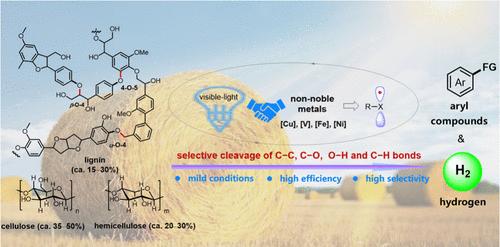当前位置:
X-MOL 学术
›
Acc. Chem. Res.
›
论文详情
Our official English website, www.x-mol.net, welcomes your
feedback! (Note: you will need to create a separate account there.)
Selective Transformation of Biomass and the Derivatives for Aryl Compounds and Hydrogen via Visible-Light-Induced Radicals
Accounts of Chemical Research ( IF 16.4 ) Pub Date : 2025-03-13 , DOI: 10.1021/acs.accounts.5c00038
Wen-Min Zhang 1 , Wen-Ting Niu 1 , Fang-Fang Tan 1 , Yang Li 1
Accounts of Chemical Research ( IF 16.4 ) Pub Date : 2025-03-13 , DOI: 10.1021/acs.accounts.5c00038
Wen-Min Zhang 1 , Wen-Ting Niu 1 , Fang-Fang Tan 1 , Yang Li 1
Affiliation

|
For sustainable development, exploring renewable resources is an urgent priority. Nonfood biomass, one of the largest renewable resources on Earth, primarily comprises three key components: lignin (ca. 15–30%), cellulose (ca. 35–50%), and hemicellulose (ca. 20–30%). Theoretically, nonfood biomass can be converted into green chemicals and energy. However, most studies have focused on the generation of chemicals and carbon-based energy under harsh conditions, often resulting in lower selectivities. Therefore, further efforts to explore efficient and selective methods for producing chemicals and hydrogen (H2) are essential to promoting the practical applications of renewable biomass. In this Account, we summarize our contributions to the efficient and selective transformation of biomass and its derivatives into aryl compounds and H2. These transformations were achieved using visible-light-induced photocatalytic systems that generate active radicals to selectively cleave C–C, C–O, C–H, and O–H bonds under mild conditions, without using noble metals. First, aryl compound production was achieved by chemoselective cleavage of C–C and C–O bonds using aryl carboxyl radicals and aryl ether radical cations. Specifically, the aryl carboxyl radical in the charge-transfer complex induced the chemoselective cleavage of C–C bonds of aryl carboxylic acids, which are platform molecules derived from lignin oxidation; the aryl carboxyl radical in free form facilitated the chemoselective cleavage of C–O bonds in the model of the 4-O-5 lignin linkage. Moreover, arenols and aryl alcohols were obtained via cooperation of the aryl ether radical cation and the vanadate-induced chemoselective cleavage of the C–O bonds of the models of various lignin linkages. Second, we developed a streamlined strategy for H2 production from biomass using a one-pot, two-step route with formic acid (HCO2H) as an intermediate for H2 storage by thermocatalysis. Using this strategy by photoredox catalysis, HCO2H was initially obtained via the alkoxy radical-induced gradual cleavage of C–C bonds in cellulose, hemicellulose, glucose, and their derivatives. Subsequently, efficient H2 production from biomass-based HCO2H was realized via hydroxyl radical (·OH)-induced C–H and the following cleavage of the O–H bonds, with cooperation of the nickel catalysis. Third, the highest H2 production capability from biomass was achieved via efficient water reforming. This process utilized alkoxy radicals followed by generated carbon cations via electrocatalysis, inducing a well-organized cleavage of C–C, O–H, and C–H bonds. We anticipate that these insights will inspire the development of more efficient, stable, and cost-effective catalytic systems, accelerating the utilization of biomass as a renewable resource and driving other related significant transformations.
中文翻译:

通过可见光诱导自由基对生物质及其衍生物进行芳基化合物和氢的选择性转化
对于可持续发展,探索可再生资源是当务之急。非食用生物质是地球上最大的可再生资源之一,主要由三个关键成分组成:木质素(约 15-30%)、纤维素(约 35-50%)和半纤维素(约 20-30%)。理论上,非食品生物质可以转化为绿色化学品和能源。然而,大多数研究都集中在恶劣条件下化学品和碳基能源的产生上,这通常会导致较低的选择性。因此,进一步努力探索生产化学品和氢气 (H2) 的高效和选择性方法对于促进可再生生物质的实际应用至关重要。在本报告中,我们总结了我们对生物质及其衍生物高效、选择性地转化为芳基化合物和 H2 的贡献。这些转化是使用可见光诱导的光催化系统实现的,该系统在温和的条件下产生活性自由基以选择性地切割 C-C、C-O、C-H 和 O-H 键,而无需使用贵金属。首先,通过使用芳基羧基自由基和芳基醚自由基阳离子对 C-C 和 C-O 键进行化学选择性裂解来实现芳基化合物的生产。具体来说,电荷转移络合物中的芳基羧基自由基诱导芳基羧酸的 C-C 键的化学选择性裂解,芳基羧酸是木质素氧化衍生的平台分子;游离形式的芳基羧基促进了 4-O-5 木质素键模型中 C-O 键的化学选择性裂解。此外,通过芳基醚自由基阳离子和钒酸盐诱导的各种木质素键模型的 C-O 键的化学选择性裂解得到芳烃和芳醇。 其次,我们开发了一种简化的策略,用于从生物质中生产 H2,使用一锅两步路线,以甲酸 (HCO2H) 作为中间体,通过热催化储存 H2。使用这种通过光氧化还原催化的策略,HCO2H 最初是通过烷氧基自由基诱导的纤维素、半纤维素、葡萄糖及其衍生物中的 C-C 键逐渐断裂获得的。随后,通过羟基自由基 (·OH) 诱导的 C-H 和随后的 O-H 键裂解,在镍催化的配合下。第三,通过高效的水重整实现了生物质的最高 H2 生产能力。该过程利用烷氧基自由基,然后通过电催化生成碳阳离子,诱导 C-C、O-H 和 C-H 键的有序裂解。我们预计这些见解将激发更高效、更稳定和更具成本效益的催化系统的开发,加速生物质作为可再生资源的利用,并推动其他相关的重大转型。
更新日期:2025-03-13
中文翻译:

通过可见光诱导自由基对生物质及其衍生物进行芳基化合物和氢的选择性转化
对于可持续发展,探索可再生资源是当务之急。非食用生物质是地球上最大的可再生资源之一,主要由三个关键成分组成:木质素(约 15-30%)、纤维素(约 35-50%)和半纤维素(约 20-30%)。理论上,非食品生物质可以转化为绿色化学品和能源。然而,大多数研究都集中在恶劣条件下化学品和碳基能源的产生上,这通常会导致较低的选择性。因此,进一步努力探索生产化学品和氢气 (H2) 的高效和选择性方法对于促进可再生生物质的实际应用至关重要。在本报告中,我们总结了我们对生物质及其衍生物高效、选择性地转化为芳基化合物和 H2 的贡献。这些转化是使用可见光诱导的光催化系统实现的,该系统在温和的条件下产生活性自由基以选择性地切割 C-C、C-O、C-H 和 O-H 键,而无需使用贵金属。首先,通过使用芳基羧基自由基和芳基醚自由基阳离子对 C-C 和 C-O 键进行化学选择性裂解来实现芳基化合物的生产。具体来说,电荷转移络合物中的芳基羧基自由基诱导芳基羧酸的 C-C 键的化学选择性裂解,芳基羧酸是木质素氧化衍生的平台分子;游离形式的芳基羧基促进了 4-O-5 木质素键模型中 C-O 键的化学选择性裂解。此外,通过芳基醚自由基阳离子和钒酸盐诱导的各种木质素键模型的 C-O 键的化学选择性裂解得到芳烃和芳醇。 其次,我们开发了一种简化的策略,用于从生物质中生产 H2,使用一锅两步路线,以甲酸 (HCO2H) 作为中间体,通过热催化储存 H2。使用这种通过光氧化还原催化的策略,HCO2H 最初是通过烷氧基自由基诱导的纤维素、半纤维素、葡萄糖及其衍生物中的 C-C 键逐渐断裂获得的。随后,通过羟基自由基 (·OH) 诱导的 C-H 和随后的 O-H 键裂解,在镍催化的配合下。第三,通过高效的水重整实现了生物质的最高 H2 生产能力。该过程利用烷氧基自由基,然后通过电催化生成碳阳离子,诱导 C-C、O-H 和 C-H 键的有序裂解。我们预计这些见解将激发更高效、更稳定和更具成本效益的催化系统的开发,加速生物质作为可再生资源的利用,并推动其他相关的重大转型。







































 京公网安备 11010802027423号
京公网安备 11010802027423号